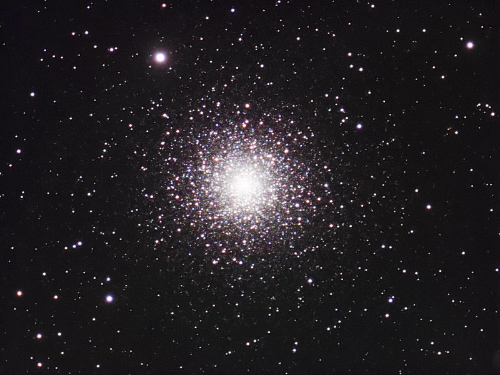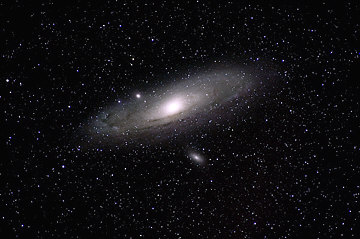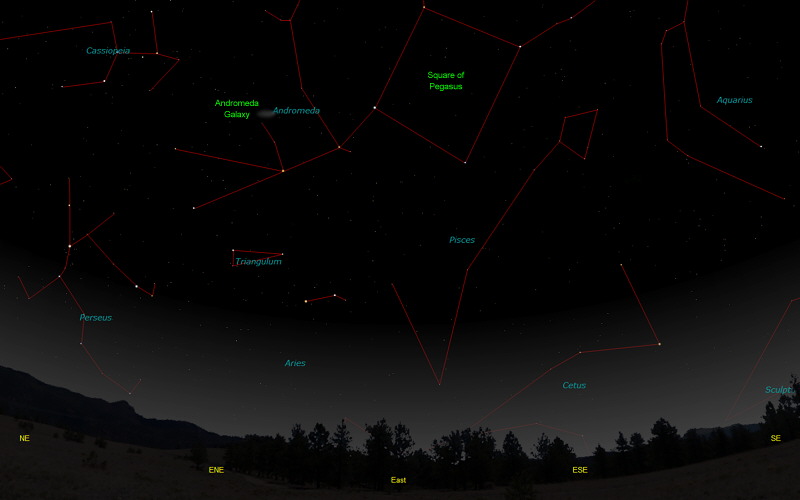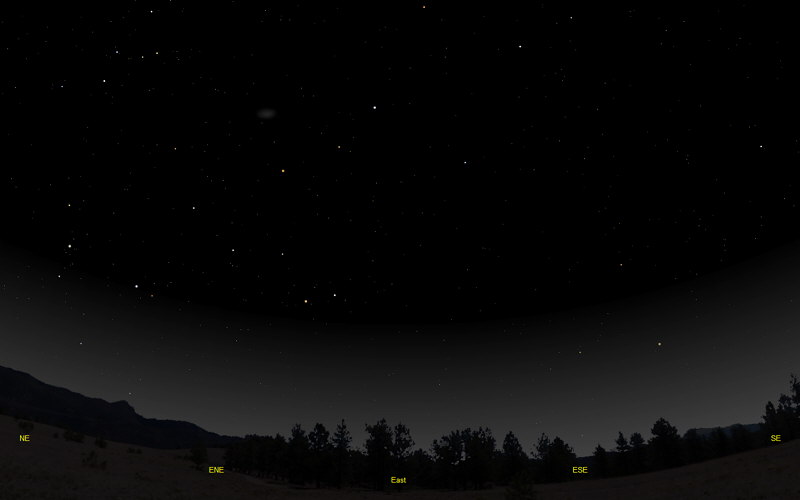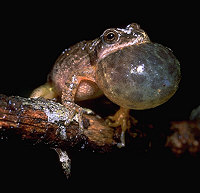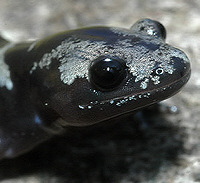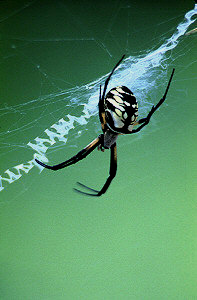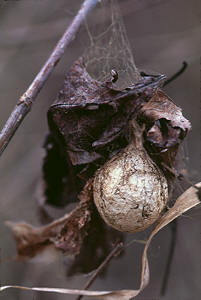The purpose of this feature is to give scout leaders, educators and naturalists an idea of some of the natural events coming up each month. We will try to cover a variety of natural events ranging from sky events to calling periods of amphibians, bird and mammal watching tips, prominent wildflowers and anything else that comes to mind. We will also note prominent constellations appearing over the eastern horizon at mid-evening each month for our area for those who would like to learn the constellations. If you have suggestions for other types of natural information you would like to see added to this calendar, let us know! Note: You can click on the hyperlinks to learn more about some of the featured items. To return to the Calendar, hit the "back" button on your browser, NOT the "back" button on the web page. All charts are available in a "printer friendly" mode, with black stars on a white background. Left clicking on each chart will take you to a printable black and white image. Please note that images on these pages are meant to be displayed at 100%. If your browser zooms into a higher magnification than that, the images may lose quality.
Notes and Images From August 2009 Pegasus rises in the early evening in August and brings some nice visual treats. The winged horse is apparently rated for aerobatics, rising over the eastern horizon upside down, its legs extending upward into the night. The bright reddish star Enif marks the nose of the horse, and about 4 degrees above the star is the globular cluster Messier 15. You can see it as a little fuzzball in binoculars in a dark sky. Messier 15 was discovered by Jean-Philippe Maraldi on September 7th, 1746, while he was searching for De Cheseaux' s Comet. Though not nearly as bright as Messier 13 in Hercules, it's still fun to track down. The cluster is about 175 light-years in diameter and 30,000 light-years away. Globular clusters like M15 are ancient, forming between 12 and 13 billion years ago. Recent evidence suggests that a black hole may be at the center of M15. On clear summer nights I often go out with just a pair of binoculars in search of globular clusters. A few of the brightest can be spotted with the naked eye. A star atlas will help guide you to them. A dark sky also really makes a difference, and you'll want a night when there is no Moon visible and the Milky Way is easy to see. Globular clusters orbit the core of our galaxy. Each of these great star cities contains up to a million stars, and for those living deep within a globular cluster, the sky would be filled with dazzlingly bright stars. There is a cost for this celestial fireworks display, however. Due to the presence of so many bright stars, the sky might never get darker than a twilight sky on earth. External galaxies would then be hidden by a twilight veil, isolating the inhabitants from the universe beyond.
Sky Events for September 2009: The Autumnal Equinox, marking the beginning of fall in the Northern Hemisphere, occurs on September 22nd at 4:19pm CDT. Evening Sky: Jupiter is already well up in the southeastern sky at dusk as the month begins. On the evening of September 2nd, between 11:43pm CDT and 1:30am CDT, all four of the bright moons are either behind or in front of the planet, giving a moonless appearance to the giant planet. This is relatively rare and will not happen again until 2019. Morning Sky: Mars rises around 12:50am at midmonth in Gemini. Venus, shining brightly at -4 magnitude, rises around 4:10am at midmonth. On September 20th Venus rises alongside the bright star Regulus in Leo. The two are separated by only 1/2 of a degree. You can use bright Venus to guide you to Mercury and Saturn at the end of the month. On September 30th, about 30 minutes before sunrise, look below Venus, about 1/2 between Venus and the horizon, for Mercury. Saturn is below and to the left of Mercury, skirting the tree tops. Binoculars will make it much easier for you to find the two fainter planets. The figure below shows the view looking east at 6:20am on the morning of September 30th.
All times noted in the Sky Events are for Franklin, Tennessee and are Central Daylight Time. These times should be pretty close anywhere in the mid-state area.
Constellations: The views below show the sky looking east at 10:00pm CDT on September 15th. The first view shows the sky with the constellation outlined and names depicted. Star and planet names are in green. Constellation names are in blue. The second view shows the same scene without labels. Pegasus appears higher above the eastern horizon this month, as does Andromeda. Perseus is above the horizon now, and Cetus is also beginning to appear. The faint stars of Pisces should be easier to pick out this month.
Find the "Square of Pegasus" and work your way outward from it to the constellations around it. See if you can pick out the faint glow of the Andromeda Galaxy, over 2 million light years away! When you look at this galaxy you're seeing light that began its journey to us in the Pleistocene epoch. To get the best look, wait until the galaxy climbs high in the sky. The Andromeda Galaxy was first shown on star charts prepared in 905AD by the Persian astronomer, Al Sufi, and was referred to as the "Little Cloud." That well describes its appearance to the naked eye. Binoculars will greatly improve your view, as will driving out of the city and finding darker skies. Simon Marius, in 1610, was among the first to observe the Andromeda Galaxy through a small telescope. He compared its soft glow to "the light of a candle shining through horn." In dark skies, those using small telescopes may pick out the small satellite galaxies M32 (above and left of the nucleus of M31 in the above image) and NGC 205 (below).
On Learning the Constellations: We advise learning a few constellations each month, and then following them through the seasons. Once you associate a particular constellation coming over the eastern horizon at a certain time of year, you may start thinking about it like an old friend, looking forward to its arrival each season. The stars in the evening scene above, for instance, will always be in the same place relative to the horizon at the same time and date each September. Of course, the planets do move slowly through the constellations, but with practice you will learn to identify them from their appearance. In particular, learn the brightest stars for they will guide you to the fainter stars. Once you can locate the more prominent constellations, you can "branch out" to other constellations around them. It may take you a little while to get a sense of scale, to translate what you see on the computer screen or what you see on the page of a book to what you see in the sky. Look for patterns, like the stars that make up the "Square of Pegasus." The earth's rotation causes the constellations to appear to
move across the sky just as the sun and the moon appear to do. If you go
outside earlier than the time shown on the charts, the constellations will be
lower to the eastern horizon. If you observe later, they will have climbed
higher. As each season progresses, the earth's motion around the sun causes the constellations to appear a little farther towards the west each night for any given time of night. If you want to see where the constellations in the above figures will be on October 15th at 10:00pm CDT, you can stay up till midnight CDT on September 15th and get a preview. The westward motion of the constellations is equivalent to two hours per month. Sky Publishing has just come out with a beautiful and compact star atlas, Sky & Telescope's Pocket Star Atlas. It is destined to become a classic, and is a joy to use at the telescope. A good book to learn the constellations is Patterns in the Sky, by Hewitt-White. You may also want to check out at H. A. Rey's classic, The Stars, A New Way to See Them. For skywatching tips, an inexpensive good guide is Secrets of Stargazing, by Becky Ramotowski. A good general reference book on astronomy is the Peterson
Field Guide,
A Field Guide to the Stars and Planets, by Pasachoff.
The book retails for around $14.00. Starry Night has several software programs for learning the night sky. Visit the Starry Night web site at www.starrynight.com for details.
Amphibians:
The frog and toad choruses start waning in September but some frogs and toads are still calling. Another name for the Spring Peeper is the "Autumn Piper", and these small frogs can be heard calling from patches of woods in the fall. Listen also for a very dry, scratchy version of the Upland Chorus Frog's song on rainy days and nights in September. Southern Leopard Frogs sometimes call and breed as the cooler temperatures mirror their early spring breeding period. We've already heard Southern Leopard Frogs at our pond in August. You can locate many of the frogs and toads that have been calling more frequently earlier in the year by driving the back roads slowly on rainy nights.
This is a two person job. One person watches the road for amphibians and one person looks out for other vehicles. Anything over about 15mph is "speeding." On wet nights in September, look for breeding Marbled Salamanders in flooded woodland areas. We found one such area where we had previously heard a breeding chorus of Upland Chorus Frogs.
Birds: Fall migration reaches its peak as September progresses. Be sure to check around ponds, river banks and on exposed mud flats for shorebirds, as many pass through Tennessee in the fall. Hawks peak around the third week in September, and you might want to consider a hawk-watching trip. For good locations, see Bird Finding in Tennessee, below. A trip to the banks of the Mississippi River this time of year can yield numerous shorebirds and large flocks of White Pelicans migrating overhead (we saw 58 birds in one flock in the fall of 2001), and Least Terns flying up and down along the river. Recommended: Bird Finding in Tennessee, Michael Lee Bierly. A classic guide to finding birds in Tennessee. The Sibley Guide to Birds, David Allen Sibley The Sibley Guide to Birds of Eastern North America, David Allen Sibley An inexpensive guide for beginners is the Golden Guide for Birds.
Spiders:
Early fall is a great time to observe spiders. One commonly seen spider this time of year is the beautiful Black-and-Yellow Argiope. The body length on the female Argiopes can range up to 1-1/8 inches long. You can sometimes spot the much smaller male Argiope (body length only about 3/8" long) at the edges of the female's web. Black-and-Yellow Argiopes are quite beneficial and feed on a wide variety of flying insects such as aphids, flies, grasshoppers, wasps and bees. Although these spiders may bite when harassed, their venom apparently does not cause problems for humans. Their webs have a characteristic zigzag pattern in the center (see the photo) called the "stabilimenta," so named because it was first thought to provide structural stability for the web.
One competing hypothesis is that the highly visible threads prevent birds from flying through the webs. After mating, the female Black-and-Yellow Argiope produces one or more papery egg sacs. These sacs (Charlotte's "magnum opus" in the book Charlotte's Web, though Charlotte was a Barn Spider) are round and up to an inch in diameter. Each sac contains from 300 to 1400 eggs. The male dies soon after mating, but the females survive until the first hard frost. The young spiderlings hatch in the fall, but overwinter in the sac and do not emerge until the spring. It's interesting to think about them riding out the winter storms in their protective home.
Archives (Remember to use the back button on your browser, NOT the back button on the web page!) Natural Calendar February 2009 Natural Calendar December 2008 Natural Calendar November 2008 Natural Calendar September 2008 Natural Calendar February 2008 Natural Calendar December 2007 Natural Calendar November 2007 Natural Calendar September 2007 Natural Calendar February 2007 Natural Calendar December 2006 Natural Calendar November 2006 Natural Calendar September 2006 Natural Calendar February 2006
Natural Calendar
December 2005
Natural Calendar
November 2005
Natural Calendar
September 2005
Natural Calendar
February 2005
Natural Calendar
December 2004
Natural Calendar
November 2004
Natural Calendar
September 2004
Natural Calendar
February 2004
Natural Calendar
December 2003
Natural Calendar
November 2003
Natural Calendar
September 2003 Natural Calendar February 2003 Natural Calendar December 2002 Natural Calendar November 2002 Nature Notes Archives: Nature Notes was a page we published in 2001 and 2002 containing our observations about everything from the northern lights display of November 2001 to frog and salamander egg masses. Night scenes prepared with The Sky Professional from Software Bisque All images and recordings © 2009 Leaps |
|||||||||||||
